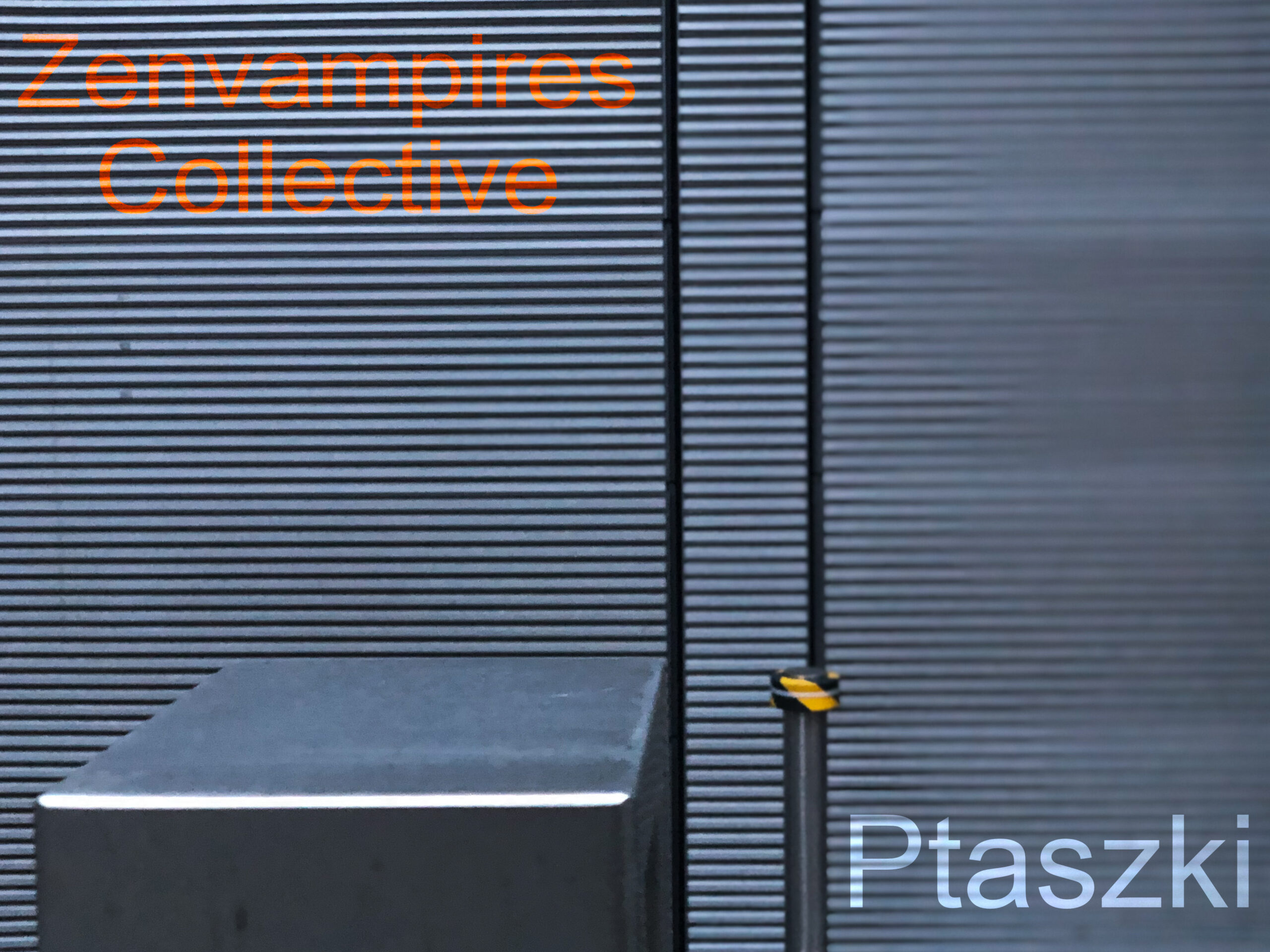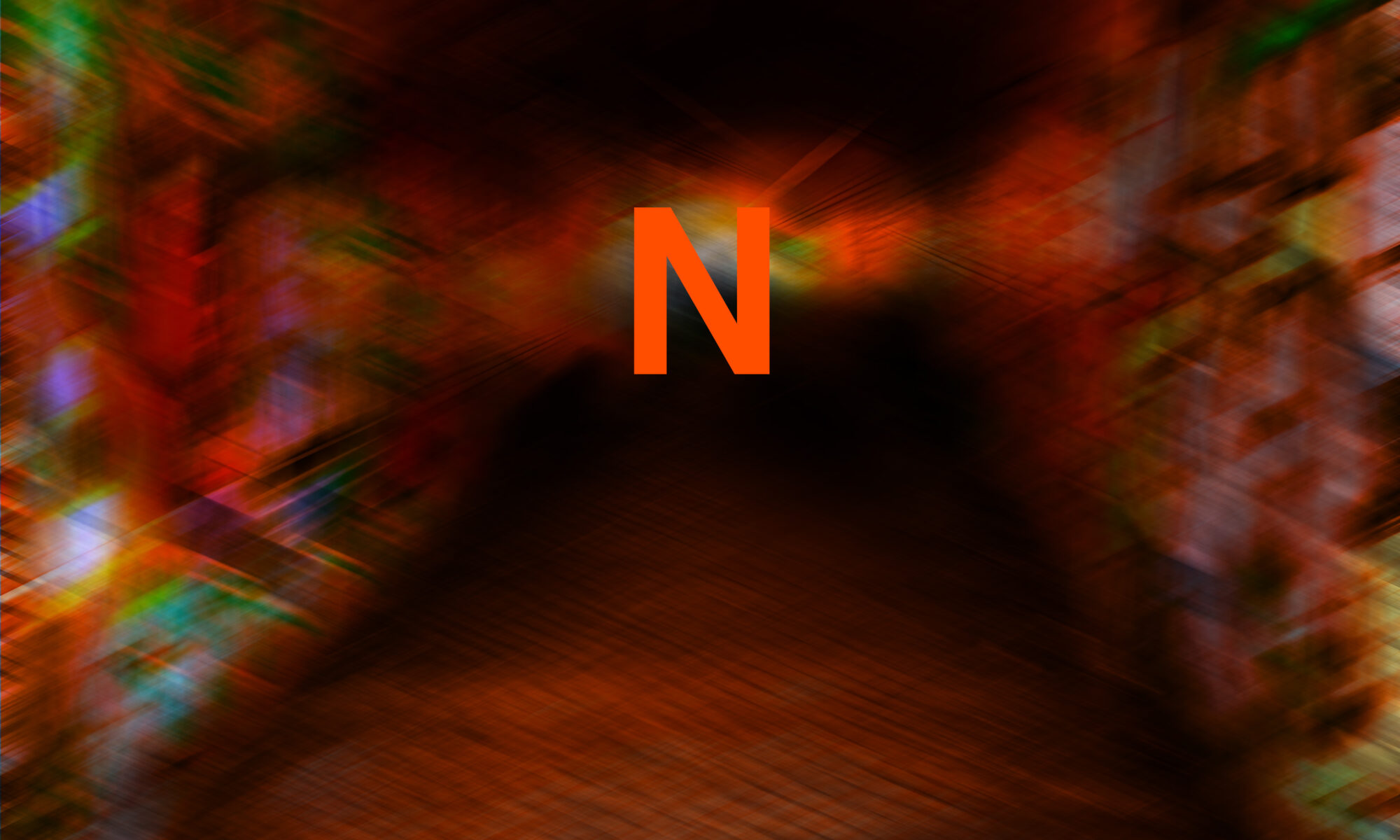Offret
OFFRET

If you water a dead tree every day, one day it will live. It is a very beautiful story, but it is suddenly interrupted. And Alexander decides to make a sacrifice. A sacrifice so that everything remains as it was. When we read Heraclitus, we know that things will never be the way they were. But it’s not so much about Heraclitus as it is about how unexpected events change people’s lives. Sounds banal. And it’s about war. Because war brutally changes people’s behaviour. Also banal. And some (quite a few, if you look around Europe) would be prepared to make a sacrifice. So that everything stays as it was. They just don’t realize that sacrifice brings nothing. And that the river of Heraclitus is still flowing.
Offret. By Andrei Tarkovsky. Not in the cinema. But maybe you can stream it.
Jeszcze się raz obudzić IV
Jeszcze się raz obudzić

8.
Obudziła się gwałtownie łapiąc ustami powietrze, jak wyciągnięta z wody ryba. Znowu mokra całą, jakby się posiusiała. Oboma dłońmi trzymała się za głowę, jak ktoś, kto leży na podłodze, a nad nim stoi zgraja bandytów, którzy go kopią. Podczas gdy inni się z daleka przyglądają. Z mieszaniną przerażenia i niezdrowej fascynacji. Niektórzy protestują. Ale jakby pro forma tylko. Bez przekonania. Czy o tym właśnie śniła? Nie. Chyba nie. A zatem o czym? Nie mogła sobie przypomnieć. I dobrze, po co wspominać koszmary? Lepiej skupić się na rzeczywistości. Ta zaś przypominała o palącej potrzebie. A więc się nie posikała, tylko spociła. Dobre i to. Choć dziwne, pomyślała, jak potrzeba tak płynna może być jednocześnie paląca? Nieważne, bo jak czegoś zaraz z tym nie zrobi, to rzeczywiście się zleje. Wstała i ruszyła omackiem w stronę drzwi. To też ją zdziwiło, to słowo, omackiem. Zwykle tak nie mówi. Zwykle mówi po omacku. Nawet nie jest pewna, czy to omackiem to w ogóle poprawnie jest. Musiałaby zajrzeć do słownika. Tylko nie teraz. Nie zna tej formy, więc skąd się wzięła w jej głowie? Może ze snu? Albo to ona nie jest sobą? No i co to właściwie znaczy? Omackiem czy po omacku, czyli co, w ciemności? Przecież z tego, co pamiętała, zwykle śpi przy włączonym świetle. Bo przecież boi się ciemności. Ale pamięć, wiadomo, rzecz zawodna. Jak śnienie zmienna, ulotna. Naraz przypomniał jej się ten zapomniany, przed chwilą przerwany sen. Ten mężczyzna w garniturze, który był podobny do jej nauczyciela chemii z liceum. Straszny był typ z niego. Należał do partii i posługiwał się sowiecką nowomową. Nie lubił jej. Kiedyś osaczył ją na osobności i powiedział, że jeśli matka i ojciec nie potrafią jej wychować, to socjalistyczne państwo musi się tym zająć. Miał na myśli siebie. Ale nie tylko ona miała z nim kłopoty, wszyscy mieli. Jednej dziewczynie to nawet prawie wybił oko. Bo miał taki zwyczaj, żeby ludzi zaskakiwać. Żeby się bali.

Każdą lekcję rozpoczynał od odpytywania kogoś na stopień przy tablicy. Wszyscy przed tym trzęśli portkami. Albo sukienkami. Bo nawet ci, którzy całkiem nieźle sobie z tą chemią radzili, wymiękali, kiedy ciskał w nich, niczym przystrojony w kolorową spódniczkę z piór wojownik z buszu, dzidą. To znaczy niespodziewanym poleceniem. Zwykle wyglądało to tak: “Pazdro, numer 134. Odpowiedź proszę.” To wszystko, co mówił. Żadnych wyjaśnień. Każdy wiedział, że chodzi o zbiór zadań z chemii, którego autorem było jakiś Pazdro. Po kilku latach nieustannego wałkowania, cała klasa znała te zadania niemal na pamięć. Ale żeby pamiętać, jaka była treść tego akurat zadania, numer 128? I nie pomylić go z zadaniem numer 127 albo 129? To już mało kto potrafił. Dlatego wszyscy się modlili, żeby na nich nie padło. Chemik dobrze o tym wiedział, dlatego przeciągał tę chwilę, cieszył się ich strachem. Jak Dżugaszwili, syn Wissariona, na posiedzeniu komitetu bezpieczeństwa. Świr jeden. Teatralnym krokiem szedł między rzędami od tyłu klasy ku przodowi i mówił: A dziś do odpowiedzi pójdziesz – powtarzał, ale na nikogo na razie nie wskazywał. Napięcie rosło. Aż w pewnym momencie robił zwrot przez lewy albo prawy bark i strzelał palcem w jakąś nieszczęśniczkę. Albo nieszczęśnika. To znaczy gwałtownym gestem wyrzucał przed siebie rękę w wyciągniętym palcem wskazującym. No i raz tak się zdarzyło, że przesadził. Źle oszacował odległość i wetknął ten swój wstrętny paluch jednej z dziewczyn w oko. Tej najwyższej z nas.
Wszystko to w jednej chwili stanęło jej przed oczyma, kiedy szła przez ciemny pokój ku drzwiom. Na koniec przypomniała sobie to, co ten mężczyzna we śnie, podobny do jej nauczyciela, pisał na tablicy. Chwilę przedtem, zanim symbole chemiczne zmieniły się w słowny komunikat. W tamtej, sennej rzeczywistości, widziała wzór dokładnie, rozpisaną na atomy strukturę, ale nie potrafiła go rozpoznać. Teraz, choć samego wzoru już nie widziała, wiedziała, o co w nim chodziło – o płyn Lugola. Po awarii reaktora w Czarnobylu w 1986 roku nazywany przez dzieci radziecką coca-colą. Bo gorzki w smaku. I co, od tego się taka mokra zrobiła? Możliwe, bo nawet teraz wpadła w panikę, przypominając sobie tamte czasy. Tamten strach. Albo wcześniejszy. Strach, który towarzyszył jej narodzinom. Bo przyszła na świat w listopadzie 1962 roku. W decydującym momencie kryzysu kubańskiego. Kiedy świat od zagłady dzieliła chwila tak krótka, jak czas potrzebny na to, by pociągnąć za wajchę. Nacisnąć włącznik. Guzik uwalniający rakietę z ładunkiem jądrowym.
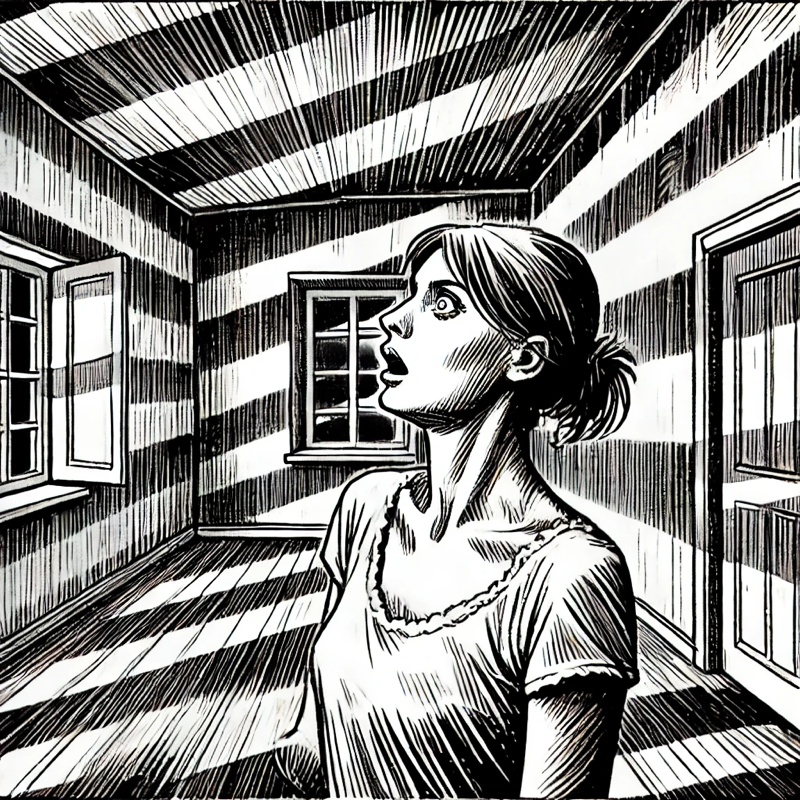
Pod wpływem paniki odruchowo rzuciła się do przodu. Jednak tam, gdzie spodziewała się znaleźć otwarte drzwi, natrafiła nosem na zamkniętą ścianę. Czyżby znowu drzwi były, pomyślała z irytacją, masując obolały nos, w innym miejscu? Nie dosyć tej zabawy? Odszukała włącznik i zapaliła światło. Rozejrzała się dokoła. Raz, drugi, trzeci. I jeszcze kilka razy. Po czym przetarła oczy ze zdumieniem. Uszczypnęła się w ramię, by sprawdzić, czy czasem nie śni. Ale wyglądało na to, że tym razem wszystko to już dzieje się na jawie. Jeśli takowa w ogóle istnieje. Bo zabolało. Tylko pokój nie wyglądał tak, jak w rzeczywistości powinien. Nie było drzwi. Żadnych drzwi. Na żadnej ze ścian. Ani okna nawet nie było. Jak w jakimś schronie. Dobrze, że chociaż ściany są. Bo bez tego byłoby zimno jak na Syberii. Dobrze, że prąd jest, że żarówka, bo bez tego nic by nie widziała. Nie jest przecież jedną z tych kobiet, z tej powieści o kobietach, które potrafią same z siebie generować energię elektryczną. Zadawać nią ból albo śmierć. W zależności od potrzeb. I dzięki temu zdobyć władzę nad facetami.
To be continued…..
Text ©Luiza Poznańska
Pics DALL•E
Prompts by Zenvampires
Jeszcze się raz obudzić III
Jeszcze się raz obudzić

5.
Obudziło ją jak zwykle światło. Oraz dokuczliwe parcie na pęcherz. Też jak zwykle. Jedyna odmiana to owo niepokojące pytanie, kto śpi z klamką w łóżku. To znaczy z łomem. Kto śpi z łomem w pościeli, z klamką w ręku. Jakoś tak. Słyszała je we śnie, lecz obudziła się, zanim poznała odpowiedź. Może zresztą nie miało być żadnej odpowiedzi? Może dlatego właśnie tak gwałtownie się obudziła? Ale nie czas teraz na takie pytania, pomyślała, bo terror nabrzmiałego pęcherza radykalnie zawężał pole walki. Jak zwykle więc wstała i skierowała się do drzwi. To znaczy chciała się skierować. Ale okazało się, że nie ma dokąd. Bo drzwi nie było. To znaczy były. Ale w innym miejscu. Jak zwykle. W tym, gdzie przedtem było okno. Tylko że to drugie, przy łóżku. Jak to możliwe? Nie wiem i nie będę się teraz nad tym zbyt głęboko rozwodziła, uznała, bo jeszcze chwila i się posikam. A poza tym pewnie i tak niczego mądrego nie udałoby się wymyślić. Bo nawet jeśli to nie jest możliwe, to co niby z tego? Jeśli i tak trzeba się z tym realnie zmierzyć. Jak z każdym problemem. Chwyciła łóżko, które blokowało dostępu do drzwi, pociągnęła. O dziwo, nie stawiało wielkiego oporu, dało się całkiem łatwo na bok odsunąć. Tak, że mogła podejść i pociągnąć za klamkę. Ale ta, mimo że ciągnęła energicznie, czegoś się nie dała. Co, znowu atrapa? Przyjrzała się uważnie. Nie, klamka prawdziwa, bez dwóch słów. Zebrała się w sobie i pociągnęła mocniej. I jeszcze raz, jeszcze mocniej. I chyba w końcu przesadziła. Bo klamka w odpowiedzi się urwała i została jej w dłoni. Dłoń wraz z zaciśniętą w niej klamką, resztą przedramienia, poleciała na podłogę. Toczyła się po niej z łoskotem, aż znikła gdzieś pod łóżkiem. Ten hałas znowu ją obudził.
6.

Przypomniała sobie, że przecież nie ma ręki. To znaczy ma, ale nie wiadomo, gdzie. Trzeba poszukać. Tylko jak, po ciemku? Właściwie, dlaczego tak tu ciemno? Czy to normalne? Trzeba zapalić światło. Choćby łokciem. Tylko czy włącznik nie znajdował się po drugiej stronie? Po drugiej, to znaczy po której? Co to w ogóle za pytanie? Po drugiej stronie czego? Ściany, drzwi, snu, łokcia?
Dosyć tego, zdenerwowała się. Dosyć tych bzdur. Dosyć mówienia do siebie. Zamknij się! – krzyknęła w końcu. Rozwścieczona płonnością tych apeli. Postanowiła się nie patyczkować, wziąć drzwi z zaskoczenia. Niewiele myśląc, natarła na nie z byka. To znaczy niezupełnie bykiem, bo barkiem uderzyła, żeby sobie nie rozbić głowy. Taki byk to ma twarde rogi, a ona co, włosy tylko. Farbowane, żeby siwego nie było widać. Raz, drugi, trzeci. Początkowo niewiele udawało jej się zdziałać. Lecz desperacja, napędzana coraz trudniejszym do wytrzymania ciśnieniem na pęcherz, rosła wyraźnie. No i za którymś wreszcie razem drzwi puściły. I to tak niespodziewanie, że wraz z nimi wyleciała z impetem na korytarz. To znaczy niezupełnie na korytarz. A raczej zupełnie nie na korytarz. Korytarza bowiem nie było. Niczego za tymi drzwiami nie było. To znaczy było, ale takie coś, co jakby niczym było. Otchłań jakaś bezdenna, przepaść, w którą leciała jak spadochroniarka, która właśnie sobie uświadomiła, że musiała zajść jakaś pomyłka. Bo ona przecież nie jest żadnym spadochroniarzem. I że najwyraźniej wypchnięto z samolotu niewłaściwą osobę. W dodatku bez spadochronu ani niczego, czego by się można było uchwycić. Czym można by spróbować to wszystko przywołać do porządku. Wyłączyć. Nawet łomu w garści.
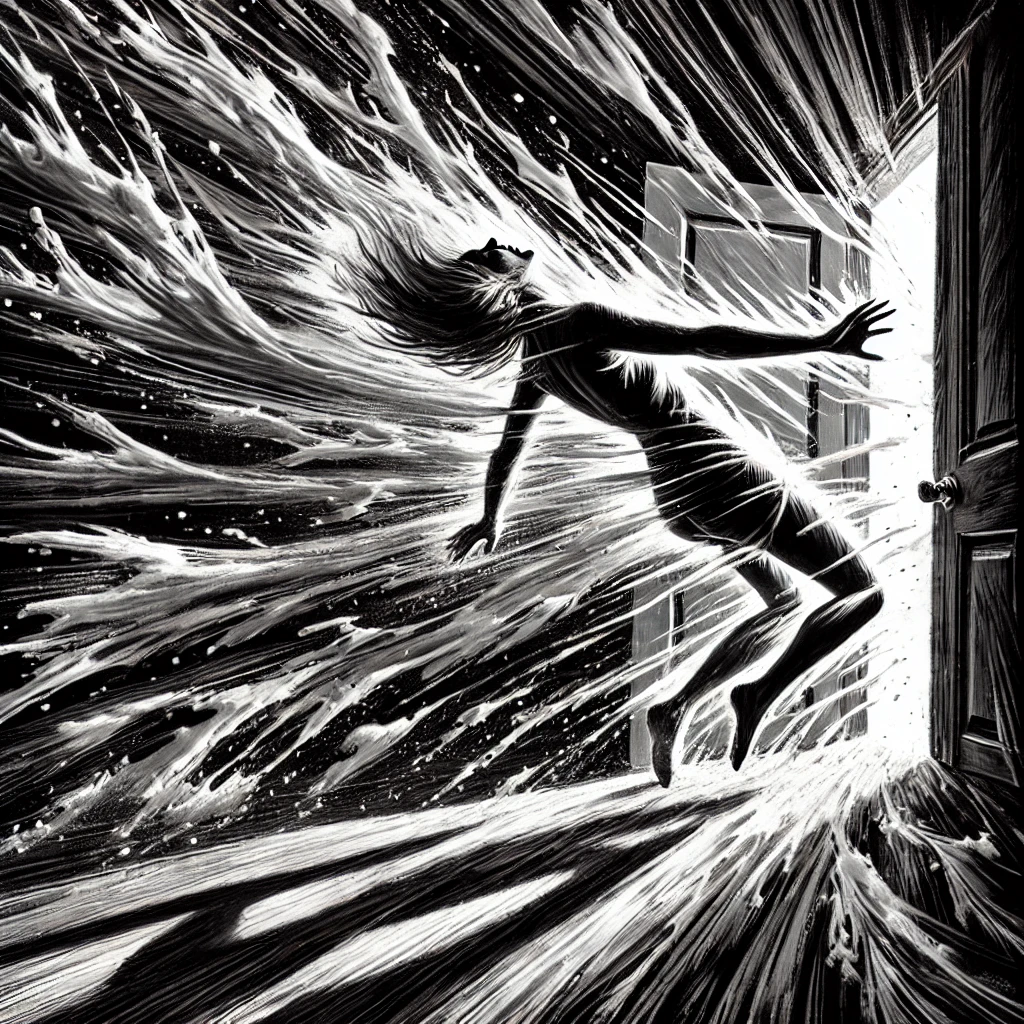
7.
Obudziła się cała mokra. Ze strachu chyba, bo przecież się nie zsikała. Gdyby była się zsikała, to nie chciałoby jej się tak bardzo, jak jej się chciało. Ucieszyła się, że nawet obudzona w środku nocy potrafi myśleć logicznie. I że trzeba wstać i udać się do łazienki, zdecydowała. Podeszła do drzwi. Idąc jeszcze, zauważyła coś dziwnego. Nie, że drzwi zamknięte. Bo to też dziwne. Ale mniej. Bardziej zaniepokoiło ją to, co pod drzwiami zauważyła. Rosnącą kałużę jakiejś cieczy. Woda? Czyżby zostawiła otwarty kran w łazience? A może rura poszła? Coś wyraźnie sączyło się ze szpary między drzwiami a podłogą. Gorzej, bo kiedy się temu bliżej przyjrzała, woda tryskała już ze szpar po obu stronach drzwi, jakby korytarz po sufit był wodą zapełniony. Sięgnęła ręką do klamki, ale zamarłą wpół ruchu. Bo nie wiedziała, co zrobić, otworzyć, czy raczej przeciwnie, docisnąć skrzydło do futryny, napierając na nie całym ciałem.
Zanim zdążyła się zastanowić, drzwi za nią zdecydowały. Odskoczyły i uderzyły z taką mocą, że odrzuciło ją na środek pokoju. A po chwili potężna struga wlewającej się przez otwarte drzwi wody cisnęła nią dalej, o ścianę. Kiedy się ocknęła, krztusiła się wodą, w której się unosiła. Brakowało jej tlenu. Pomyślała, że to koniec. Że umiera. Zaczęła gwałtownie machać rękoma i płynąć w górę, lecz zanim zdołała się wynurzyć, z impetem uderzyła głową w sufit. Ten rozbił się na kawałki. Ucieszyła się, że ma taką mocną głowę. Bo inaczej kiepsko by to wyglądało. Spojrzała w górę i zamarła. Sufit był cały. To co, głowa jej się rozbiła? Zaczęła się macać po czaszce, ale wszystko wydawało się na swoim miejscu. Bólu też żądnego nie czuła. Spojrzała jeszcze raz pytająco na sufit, a ten na jej oczach zmienił kolor, z białego na czarny. Był teraz tablicą, na której jakiś mężczyzna, jak nauczyciel w klasie, coś pisał. Jakiś wzór. Nauczyciel wysoki, w ciemnym garniturze, twarzy nie widać, bo stał tyłem do niej, przodem do tablicy. Skąpy zarost na głowie, właściwie to prawie łysina. Miała wrażenie, że go zna, ale nie wiedziała skąd. Rozpoznawała symbole i już chciała je zamienić w jakiś sens, gdy naraz zniknęły i w ich miejsce pojawiły się na tablicy słowa. Albo się obudzisz i pójdziesz do łazienki, albo zmoczysz łóżko. Tak mówiły słowa. Po rosyjsku zapisane. Mężczyzna odwrócił się do niej twarzą i wtedy go rozpoznała. Poczuła paniczny strach.
To be continued…..
Text ©Luiza Poznańska
Pics DALL•E
Prompts by Zenvampires
More than just Lusterka
More than just Lusterka

In his functional theory, Malinowski argues that we should consider all aspects of a cultural phenomenon. Not just the symbols we receive. Sometimes, however, as in the case of a piece of music, we are not aware of the social circumstances. Of course, we, the listeners, could examine the context of the artists in order to examine not only the symbols but also the circumstances.
On the one hand, we are not dealing with an unknown corner of the world (for some people it is indeed unknown, but that is not the point).
And on the other hand, the links between modern (and modern here means in the present) music and traditional singing are well known. But they could tell us a lot about our culture.
But we think it’s better to listen. And make up your own mind. Sw@da & Niczos. A duo. Music. A recommendation for this week.
Jeszcze się raz obudzić II
Jeszcze się raz obudzić
Here we present the second part of a text by Luiza Poznańska. She lives and works in Poznan and Sopot. The first one you can find here.

3.
Co jest, pomyślała z niepokojem, dlaczego w pokoju pali się światło? Czyżbym zapomniała je zgasić, kiedy kładłam się spać? Nie, to przecież niemożliwe. Nie zasnęłabym przy takim świetle. Ki diabeł więc? Rozejrzała się po pokoju, jakby szukała sprawcy. Ale w pokoju nikogo. Poza nią. Postanowiła zatem chwilowo odłożyć rozwiązanie tego problemu na później, bo chciało jej się siusiu. I to jak! Wstała i ruszyła do drzwi, i dopiero kiedy już niemal do nich doszła, zorientowała się, że doszła do czegoś, czego nie ma. To znaczy drzwi nie ma. To znaczy są, ale nie w tym miejscu, co zwykle. Znalazły się na innej ścianie. Nie na wprost łóżka, tylko po prawej. Tam, gdzie kiedyś okno było. W dodatku zamknięte. Podeszła i pociągnęła za klamkę. Ta, ku jej zdziwieniu, ani drgnęła. Jakby nie była klamką, lecz jakąś wykutą w metalu atrapą. Przyjrzała jej się dokładnie i stwierdziła, że rzeczywiście, że to atrapa. Znała się na tym, bo odebrała techniczne wykształcenie, a od jakiegoś czasu jako inżynier pracowała w sektorze zbrojeniowym, w firmie produkującej klamki i różne takie. Nie ma mowy, stwierdziła autorytatywnie, żeby się dała przekręcić, i że prędzej by ją urwać można było, gdyby tylko dysponować jakąś ponadludzką siłą. Albo łomem.
Właśnie, łomem. Że też jej to od razu nie przyszło do głowy. Wróciła do łóżka, pochyliła się i wyciągnęła łom spod kołdry. Solidny, długi, metalowy. Chwyciła go mocno w obie dłonie i wróciła z nim do drzwi. Stanęła nad klamką, uniosła łom wysoko ponad głowę. Już miała uderzyć, gdy naraz dotarła do niej cała absurdalna zagadkowość tej sytuacji. Skąd wziął się łom w jej łóżku? Kto śpi z łomem pod kołdrą? I przede wszystkim, skąd wiedziała, że go tam znajdzie?
Naraz przypomniał jej się ten sylwester sprzed lat. To znaczy dwa sylwestry. Ten pierwszy, z klamką. I drugi, z maseczką w tle i dystansem. To podczas tego drugiego nudziła się i zapisała to wspomnienie o pierwszym. “Misie noworoczne”, taki tytuł temu zapiskowi nadała. Brzmiał tak:
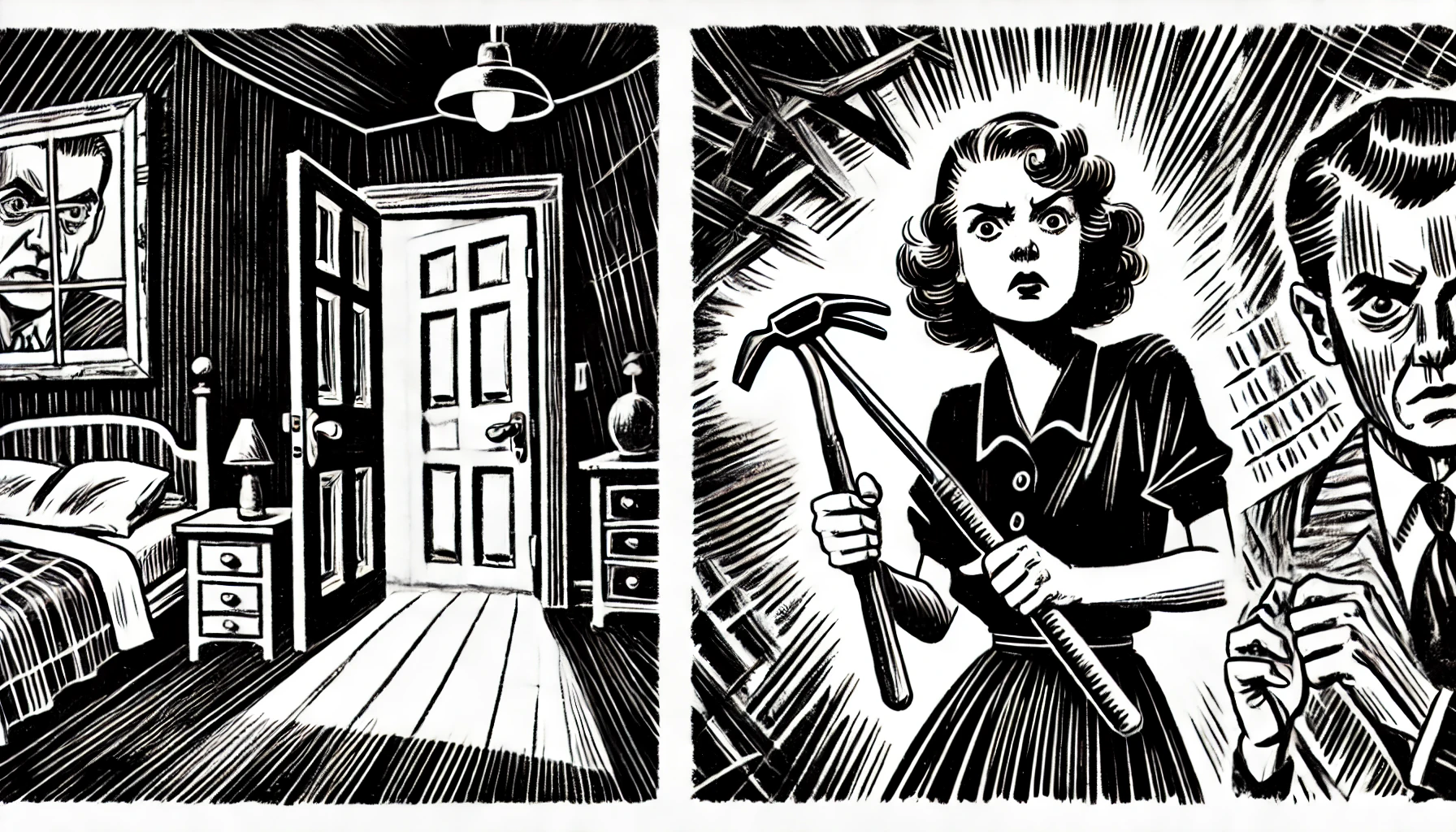
4.
Ciekawe, jak to w tym roku będzie. Z tym Sylwestrem i witaniem Nowego. Niby coś niezwykłego, ale czy to po raz pierwszy? W 1981 też tak było. To znaczy podobnie. W sensie, że nie wolno się było przemieszczać ani gromadzić. Bo ulice od 13 grudnia należały nocą do wojska. Wojna postu z karnawałem, komuny z Solidarnością i całą resztą. Imprezę urządzałyśmy sobie w kilka osób, w małym mieszkaniu typu m-4, w osiedlowym bloku. Niektórzy przynieśli ze sobą materace, bo myślałyśmy, że trzeba będzie do rana siedzieć. Siedzieć a potem leżeć, gdzie popadnie. Bo ta godzina, milicyjna czy jakaś. W ostatniej chwili ją odwołano. Na tę jedną noc. No ale w sumie, po co łazić po nocy? W dodatku po pijaku?
Mimo pewnych obaw, bo wiadomo, czasy niewesołe, bawiłyśmy się jak zwykle. Czyli dobrze. Wtedy, 31 grudnia 1981 roku. Na całego, nie na żadne pół gwizdka. Szampańsko i z przytupem. I jak zwykle, któryś z sąsiadów w końcu zadzwonił po milicję. Pewnie ten ormowiec z parteru. Przyszli. Nie milicja, tylko żołnierze. Czyli tak bardziej na poważnie. Uzbrojeni. Ale bez hełmów. Normanie, w pluszowych czapkach z podniesionym daszkiem i wielkimi nausznikami, tasiemką pod brodą zawiązanymi. Dwóch przyszło, starszy i młodszy. Było już koło trzeciej. Zadzwonili do drzwi, ale nikt nie usłyszał. Więc nie było nawet: – Jeb, jeb! – Kto tam? – Harcerze. – O tej porze harcerze? Nie wierzę. – Otwieraj chamie, ZOMO nigdy nie kłamie. Zapomnieliśmy zamknąć, weszli sami. Na początku było trochę nieprzyjemnie. Bo kazali wyłączyć muzykę i takie tam. Jak to zwykle w takiej sytuacji. Ale żołnierz też człowiek, nawet jeśli reżimowy. A człowiek, wiadomo, zawsze spragniony. Zwłaszcza w sylwestrową noc. A nam wódki nie brakowało, właściwie to już wszyscy miałyśmy jej dosyć, więc dałyśmy im się napić. Usiadłyśmy z nimi przy jednym stole. Ten starszy był młodszy. To znaczy młodszy z dwóch żołnierzy był starszy rangą. Więcej miał tego gówna na ramionach. Znaczy belek czy czegoś tam. Był też dużo większy od tego drugiego, jakiś taki misowaty. I miły do tego, jak się szybko okazało. Swój chłop, jak to mówią. Choć prosty. Rozmawialiśmy o tym, jak to w wojsku jest. W ogóle i teraz, w stanie wojennym. Sypali anegdotkami i wychylali kieliszki, jakby w fabryce przy taśmie robili, machinalnie, raz za razem. Chyba dobrze się z nami bawili, zdjęli czapki, płaszcze i tak dalej. To znaczy dalej to właściwie nie pamiętam.

Obudziłam się wcześnie, jakimś ciemnym, zimowym świtem. Ciśnienie mnie obudziło i kazało szybko biec do łazienki. Szybko, ale też ostrożnie, by nie nadepnąć śpiących na podłodze. Kiedy się załatwiłam, wróciłam do pokoju. I tam mnie dopadł. Trampek w ryju, jak to chłopcy określali. Normalnie Sahara jakaś. Albo Błędowska. Kac mnie dopadł. Napić się, natychmiast! Tylko czego? Poszłam do kuchni, otworzyłam lodówkę. Wyglądało na to, że jakimś cudem wszystko nam się udało wytrąbić. W końcu gdzieś na podłodze znalazłam butelkę z niedopitym piwem. Bo puszek wtedy nie było. Mówiło się, że socjalistyczna gospodarka dobra jest w stali, ale tylko tej grubej, do czołgów. Produkcja cienkiej blachy, takiej jak do puszki z kokakolą, jakoś nam nie wychodziła. Podobnie jak produkcja tego napoju. Jakaś polokokta wychodziła, brunatna jak Miś. Film taki. Z tego samego, 1981 roku. To znaczy jak łycha z tego filmu. Ruda, jakby na myszach.
Wróciłam do pokoju, usiadłam w fotelu, podniosłam butelkę do ust. I wtedy ją zobaczyłam. Klamkę. Leżała na stole, tak po prostu. Pośród niedopitych kieliszków, pustych szklanek i butelek, nie do końca opróżnionych półmisków z ziemniaczanymi, jajecznymi, śledziowymi sałatkami, brudnych talerzy z niedokończonymi kromkami chleba z masłem. W skórzanej kaburze nanizanej na gruby, wojskowy pas z metalową klamrą. Usiadłam w fotelu, podniosłam, odpięłam, wyciągnęłam. Ciężka, jakby z prawdziwej stali była. Pewnie była. Czego się spodziewałam? Że z plastiku? Chłodna w dotyku i śliska. Jak jakiś wąż. Nigdy wcześniej nie miałam czegoś takiego w ręku. Otworzyłam usta, wsunęłam. Nie, co za pomysł! Wysunęłam, przed siebie. Wymierzyłem do żołnierza, który spał na kanapie. To znaczy obaj tam spali. Nie pamiętam, do którego konkretnie. Do obu naraz? Zastanawiałam się, czy ich strzelić. Choć może niezupełnie na serio – bo chyba wiedziałam, że tego nie zrobię. Nawet nie odbezpieczyłam. Nie widziałem też, czy trzeba przeładować. Ani jak to zrobić. Bo i skąd? Zajęcia z przysposobienia do życia obronnego mieli tylko chłopcy. Poborowi. Była to zatem raczej gra z wyobraźnią, zabawa, nie poważny pomysł. No bo jakbym ja, zadeklarowana pacyfistka, miała kogoś życia pozbawić? Nawet jeśli na to zasługiwał? Ale czy rzeczywiście zasługiwał? Przecież w sumie to prawie nic o nim nie wiedziałam. Ani o jednym, ani o drugim misiu. Więc bardziej chyba zastanawiałam się nad tym, próbowałam sobie wyobrazić, jak by to było, gdybym ich strzeliła. Co by to w moim życiu zmieniło? Albo w tej sytuacji tylko? Bo wszystko tu takie jakieś niedokończone, niejasne, niejednoznaczne – i naraz proszę – taki zdecydowany, definitywny akt na sam koniec. Jak seta mocnej wódy zamiast drinka z kolą. Jak wypchnięcie z pociągu tego obcego kolesia, przez Lafcadia, u Gide’a. Akt filozoficznej bezradności. Czyn bezzasadny, a zarazem zasadny, bo polityczny.
Tak sobie rojąc zasnęłam. Tak jak siedziałam, w tym fotelu. Pierwsze, co zobaczyłam, kiedy się obudziłam, to ten starszy. Nie wiekiem, tylko belkami. Ten niby bardziej miły. Stał z pałą nad moją głową. A ten młodszy chwycił mnie za klamkę. Od tamtej noworocznej nocy nic już nie było tak, jak kiedyś. Wszystko inaczej. Jakbym kimś innym się stała. Jakbym coś ważnego utraciła. A zarazem zyskała. Nie potrafię zdecydować. W każdym razie to był mój pierwszy raz, z tą klamką. Miałam wtedy 19 lat. I byłam piękna. Dziś, 31 grudnia 2020, to już pewnie pięćdziesiątka na karku będzie. I to z okładem. Z jednej strony, dużo się przez ten czas zmieniło. Z drugiej jednak, niewiele. Może nawet nic. Zwłaszcza te dwa sołdaty. Jak stali, tak dalej nade mną stoją. Gdzie tylko się obudzę, oni już tam są.
To be continued…..
Text ©Luiza Poznańska
Pics DALL•E
Prompts by Zenvampires
Jeszcze się raz obudzić
Jeszcze się raz obudzić
Here we present a text by Luiza Poznańska. She lives and works in Poznan and Sopot. It is the first part of a multi-part series that we are proud to present to you.

Obudziła się w pełni świadoma ultimatum, jakie jej postawiono. Albo wstaniesz i pójdziesz, wiesz gdzie, albo – sama wiesz. Tak to mniej więcej brzmiało, białą kredą na czarnej tablicy wypisane. To znaczy nie od razu. Bo najpierw był jakiś wzór chemiczny. Na tej tablicy. Nie zapamiętała, jaki konkretnie. Zapamiętała za to, że wzór chwilę po zapisaniu – kto to zrobił, tego też nie pamiętała – zamienił się w słowny komunikat. Nie wiedzieć czemu, cyrylicą, po rosyjsku sformułowany. Prosty, bezwzględny w treści. Nie było sensu się spierać. Posłusznie wstała i podeszła do drzwi, którymi zwykle wychodziła z pokoju na korytarz, by stamtąd przejść dalej do łazienki. Drzwi były zamknięte. Dziwne, nigdy ich przecież nie zamykała na noc. No bo po co? Żeby się udusić? Nic to. Zamknięte, trzeba rozewrzeć, prosta sprawa. Chwyciła za klamkę, nacisnęła, popchnęła. Drzwi ani drgnęły. No tak, zreflektowała się, i tym razem pociągnęła. Otworzyły się, owszem, ale tylko trochę. Pociągnęła mocniej i poczuła, że się zablokowały. Szpara między ościeżnicą a skrzydłem była na tyle szeroka, by wetknąć tam rękę. Albo dwie. Może nawet głowę. Ale zbyt wąska, by się przez nią przecisnąć. Wetknęła w szparę lewą stopę, zaparła się i jeszcze raz, tym razem mocniej, pociągnęła. Nic z tego. Co też mogło je, pomyślała, zablokować?
Drugą, wolną dłonią sięgnęła do kieszeni bluzy, w której spała, wyciągnęła telefon. Nacisnęła i pojawił się ekran blokady, z dużym, analogowym zegarem. Bo tak sobie ustawiła. Zegar wskazywał kilka minut na czwartą. Przesunęła palec wskazujący tak, by znalazł się na czytniku z tyłu telefonu. Ekran blokady zmienił się w ekran startowy. Wetknęła telefon w szparę i skierowała wyświetlaczem w dół, ale to niewiele dało. Nadal nie widziała, co z tymi drzwiami. Światło było za słabe. Odwróciła telefon w dłoni i poszukała ikonki uruchamiającej funkcję latarki. Ale kiedy ją naciskała, telefon wysmyknął jej się i poleciał na podłogę. Uderzył o coś z hałasem i zgasł.

Nie puszczając klamki, schyliła się i pozwoliła lewej dłoni zjechać po krawędzi skrzydła do podłogi. Próbowała wymacać telefon. Przy okazji natknęła się na to coś, co wcisnęło się między drzwi a podłogę. Dotknęła, nacisnęła. Miękkie od spodu, z wierzchu kościste. Co by to mogło być? Przebiegła palcami. Kształtem jakby członek. Pancerzyk na czubku. Zimne u nasady. Metal? Obrączka? Chwyciła mocniej, ścisnęła, aż dotarło do niej, że trzyma w ręku paluch. Swój własny, od prawej stopy. Poczuła krew pod palcami. I wtedy dopiero odezwał się ból. Z opóźnieniem, za to ze zdwojoną mocą. Zawyła, próbując jednocześnie wyrwać stopę spod drzwi. I to wreszcie, ten krzyk, ten ból, wszystko naraz, ją obudziło.
- Usiadła na łóżku z uczuciem pustki w głowie. Wiedziała, że coś się stało. Ale co? Jakaś klamka, jakiś – naraz przypomniała sobie. Krew na palcach! W panice chwyciła się za prawą stopę. Krwi ani śladu, bólu też już żadnego nie czuła. Odetchnęła z ulgą. A więc to był tylko sen. Dla pewności sprawdziła też lewą stopę. Nic. A więc sen. Albo jakiś nagły atak tej niby królewskiej choroby, dny moczanowej. Atak, który na chwilę się rozszalał i ustał zaraz po tym, jak udało mu się ją obudzić. Bo do królestwa śnienia przynależał. Sen, zdolny koleś, nie takie figle płatać potrafi. Oczywiście nie dla zabawy, ma w tym jakiś swój cel. W tym wypadku chodziło – tu poczuła, jak bardzo chce się jej siusiu i zrozumiała od razu, że o to właśnie chodziło – żeby się do łóżka nie zlała. Tyle razy już sobie mówiła, że trzeba skończyć z tym zwyczajem picia wina przed snem. Mówiła rano, wieczorem zapominała. Więc jest, jak jest.

Nie zwlekając wstała i ruszyła do drzwi prowadzących do korytarza, wystawiając przed siebie obie ręce. Ale szybko się zreflektowała, że samo wyciągnięcie nie wystarczy. Że lepiej machać. Bo przypomniała sobie, jak ktoś kiedyś jej opowiadał, że też tak szedł w ciemności w stronę drzwi, że z ostrożności wystawił przed siebie ręce, po czym wszedł w te drzwi tak, że jedna ręka była po ich lewej, druga po prawej drzwi stronie, i zanim się zorientował uderzył twarzą w krawędź skrzydła. Rozcinając sobie obie wargi i tracąc ząb. Jeden albo dwa, nie była pewna. Ale jej drzwi były zamknięte, o czym się przekonała, kiedy machając rękoma natrafiła na ich powierzchnię. To z jednej strony dobrze, przynajmniej nie zrobi sobie krzywdy. Z drugiej, dziwne. Przecież powinny być otwarte. Ale mniejsza o to. Przesuwając dłonią po drewnie wymacała klamkę. Chwyciła za nią i poczuła zimny metal pod palcami. Jak błyskawica, skrajem dzikich pól jawy przeleciała jej ta obrączka ze snu. Nacisnęła. I nic. Nawet żeby dłoń wetknąć. Chociaż palec. Zero reakcji. Jakby na klucz zamknięte. Ale jak to, przecież nie miała klucza, więcej, te drzwi nigdy nawet zamka nie miały. Więc jak można by je było zamknąć? Pociągnęła jeszcze kilka razy za klamkę, za każdym razem z tym samym skutkiem. Włączyła światło, żeby lepiej się przyjrzeć i ta jasność ją wreszcie na dobre obudziła.
To be continued…..
Text ©Luiza Poznańska
Pics DALL•E
Prompts by Zenvampires
SLOW DOWN. PLEASURE UP.
SLOW DOWN. PLEASURE UP.
©by Yuki K.
„Ich mache was die anderen tun.
Und das ist nicht sehr viel“

Berlin langweilte Robert sehr. Er nahm einen Job als Reisebegleiter. So erkundete er halb Europa. Mit Rentnergruppen fuhr er nach Wien, liess sich in Moskau ablichten und schaute tanzenden Mädchen in Paris zu. Robert war schon immer sehr nett. Seine Schützlinge mochten ihn sehr.
In Venedig dachte Robert, der Job sei stupide. Er verliess die Reisegruppe an der Lagune. Mit einem Bus reiste er nach Nizza und dann nach Madrid. Hier traf er kurz Adrian. Robert kannte Adrian noch von der Sache in Cleveland, Ohio. Adrian freute sich sehr. Sie gingen kurz in die Bar PABLO PICASSO was trinken und besprachen alte Zeiten. Es war ein kurzer Besuch. Denn die spanische Polizei suchte überall nach ETA Terroristen. Sie verdächtigte alle und jeden. Robert fühlte sich unwohl. Und auch weil er Angst hatte, erkannt zu werden. Er besorgte sich falsche Papiere und verliess Madrid mit dem nächsten Flieger.
In London nahm er Kontakt zu John Davoy, dem bekannten Gesichtschirurgen. Schon länger dachte Robert über eine Gesichtsoperation nach. „Es lässt sich machen“ – sagte Davoy, dessen Eltern 1956 aus Indien nach England kamen auf Suche nach Arbeit. Davoy konnte es ihnen nicht verzeihen. Er hasste Gross Britannien wie die Pest. Alle Terroristen der Welt vertrauten ihm. Sie wussten. Er würde sie nicht verraten. Auch Robert war sich sicher.
In London erreichte ihn eine Nachricht aus Berlin. Man habe seine Wohnung durchsucht. Er sei in Gefahr. Robert wusste was zu tun ist. Er hatte keine andere Wahl. Jahrelange Erfahrung hat ihn erhärtet. Da er Geld brauchte, überfiel er die North Amerriccan Global Bank in London. Mit der Beute flog Robert über Prag und Budapest nach Teheran. Von dort fuhr er mit einem kleinem Auto Richtung China und verschwand für einige Zeit von der Bildfläche.

Es war der 17.05.2005 und niemand konnte sagen, wo er sich befindet. Der Mossad berichtete Roberts Spuren in Syrien gesichtet zu haben. Die CIA schickte Truppen nach Kuwait um von dort gegen Robert zu operieren. Man versuchte seine Geldoperationen zu verfolgen und sein Handy anzuzapfen. Vergeblich. Gleichzeitig nutzte der BND seine stets guten Kontakte zu Bagdad um an Informationen über Robert ranzukommen. Man vermutete ihn in Afghanistan oder Pakistan. Wobei man nicht sicher war, ob Robert mit dortigen Terrorzellen Verbindung aufgenommen hatte. Es war eher unwahrscheinlich. Hingegen etliche Terrorspezialisten in etlichen Frühstückssendungen und Guten-Morgen–Programmen etlicher Fernsehkanäle behaupteten, Robert sei in Wahrheit in Indonesien, auf den Philippinen oder in China.
Derweil verbrachte Robert seine Zeit in Cape Town. Er erholte sich nur langsam von seiner Gesichtsoperation und dachte darüber nach, sich niederzulassen. Er studierte Immobilienkataloge. Er hatte es satt immer auf der Flucht zu sein.
In Cape Town lernte Robert Janina kennen, ein junges Mädchen aus den Slums Johannesburgs auf der Suche nach sich selbst. Janina war immer in Eile. Sie hastete von Job zu Job und vom Abenteuer ins Abenteuer. Nachts beobachteten sie die Sterne von Roberts Apartment aus. Und an guten Tagen glaubte Robert die Antarktis sehen zu können. Weit, hinter dem Horizont.

Janina liebte Robert sehr. Sie sagte, er sei ihr einziger Halt. Eines Tages, nachdem sie sich geliebt haben, hielt sie seine Hand, schaute ihm in die Augen und fragte: „Sag mir, wer bin ich? Wer bin ich wirklich?.“ „Niemand.“ – antwortete Robert ernst – „Es gibt Dich gar nicht. Du bist nur ein Hauch der Zivilisation.“ Janina verstand es nicht. Sie wurde sauer und nannte Robert einen „Spinner.“
Nach 3 Monaten war Robert wieder fit . Er verliess Janina und flog nach Zürich. Hier löste er seine Konten auf. Er wusste, was zu tun ist. Doch bevor er es tat, wollte er es noch einmal erleben. Er wollte noch einmal seine geliebte Wüste sehen. Sie in sich spüren. Sie anfassen und berühren. Er reiste nach Kairo und von dort auf einem Kamel ostwärts. Richtung Libyen.
Der 21 September war ein schöner Tag. Der schönste in Ägypten. Der warme Wind vom Westen strich leicht über Roberts Haar. Ein Insekt brummte in der Nähe. Dann flog er weg. Man hörte NICHTS. Robert spürte es. Die Wüste. Sie durchdrang seinen Leib. Brach in ihn hinein. Nahm ihn mit sich und trug weg. Robert bewegte sich nicht. nur der leichte Wind berührte behutsam die Enden seiner Armhärchen. Er war ruhig. Vollkommen ruhig.
Die Schüsse kamen plötzlich. Sie trafen Robert direkt ins Herz. Zwei weitere in sein Kopf. Er war sofort tot. Sein Körper lag ausgestreckt. Nur die kleinen Photonen von der Sonne kommend durchrasten ihn mit Lichtgeschwindigkeit. Man sagt, sie sind Materie und Welle in einem. Robert konnte es nicht mehr feststellen. Die Photonen flogen weiter in die Tiefen des Weltraums.
Danach passierte nichts.
Der Kapitalismus hörte auf zu existieren.
About a film. And different perceptions of reality.
About a film. And different perceptions of reality.
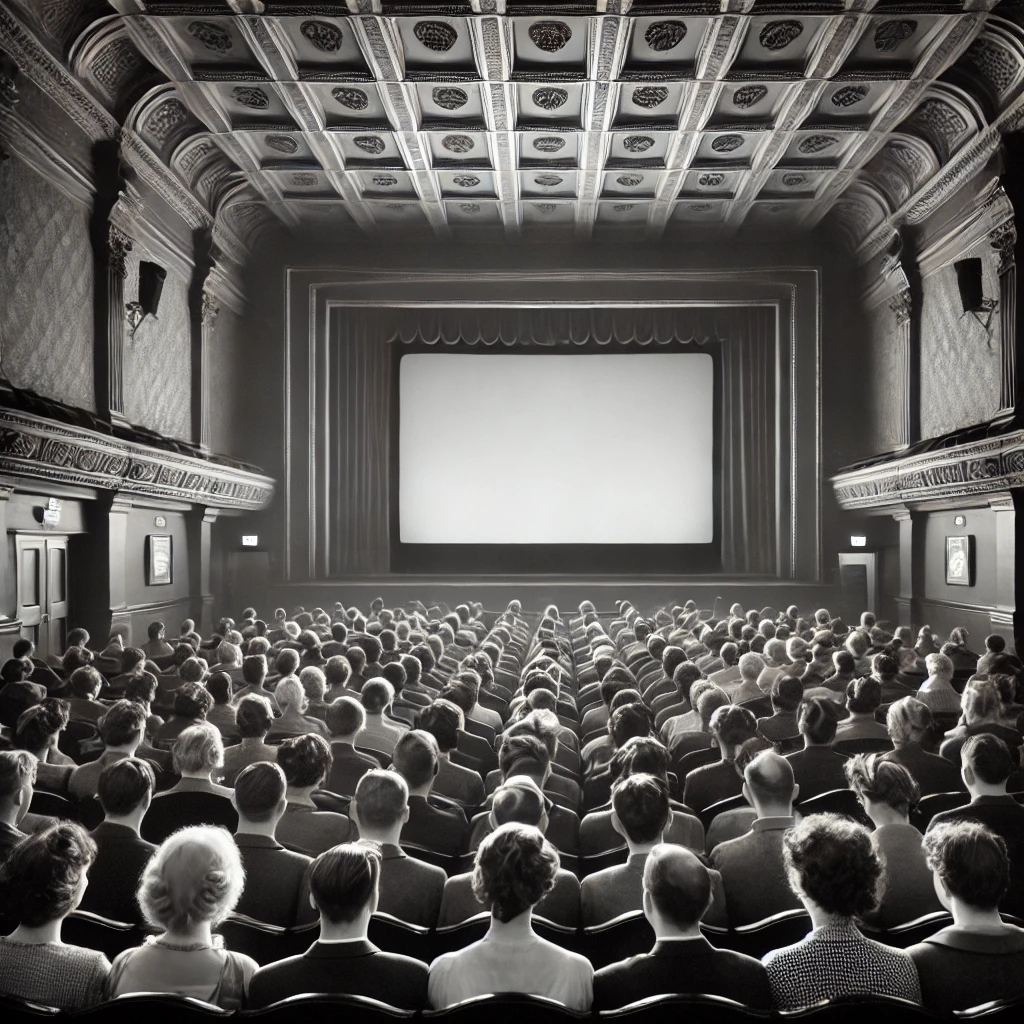
Sometimes realities are created. From expectations. Maybe through influences. Or simply by expectation and experience. And sometimes we are told about perspectives. But in truth they are realities. One is Elisabeth Sparkle’s in The Substance. The viewer has a completely different reality. Who, quite by chance, heard in October that the film had received an excellent rating. But what are ratings? The viewer’s reality. Maybe.
It could have been very good. And it was. The film. Up to a certain point, it tells of two different realities that intertwine and, after a certain point, also fight each other. People who are trapped in their own realities sometimes tend to fight. It was about another reality that the director maybe didn’t work out so well. Or she did, but it wasn’t visible. What is that reality, the struggle for youth in the face of the fact that we are all going to die? But that’s not what I wanted to write about. It’s not about the existentialism of the film or the question of metaphysics. It’s about dying. What is beautiful for the Japanese. And what has no place in our reality.

So what about the different realities in The Substance? Well, almost everything is about them. For people who believe in only one reality, it will still be exciting. People who are used to living with different realities will enjoy it.
And what about the reality of rating? Nothing. You shouldn’t be influenced by other people’s realities. See for yourself. At the cinema you trust.
This text is created by humans. The pics are not.
Eurorack Diaries
Eurorack Diaries
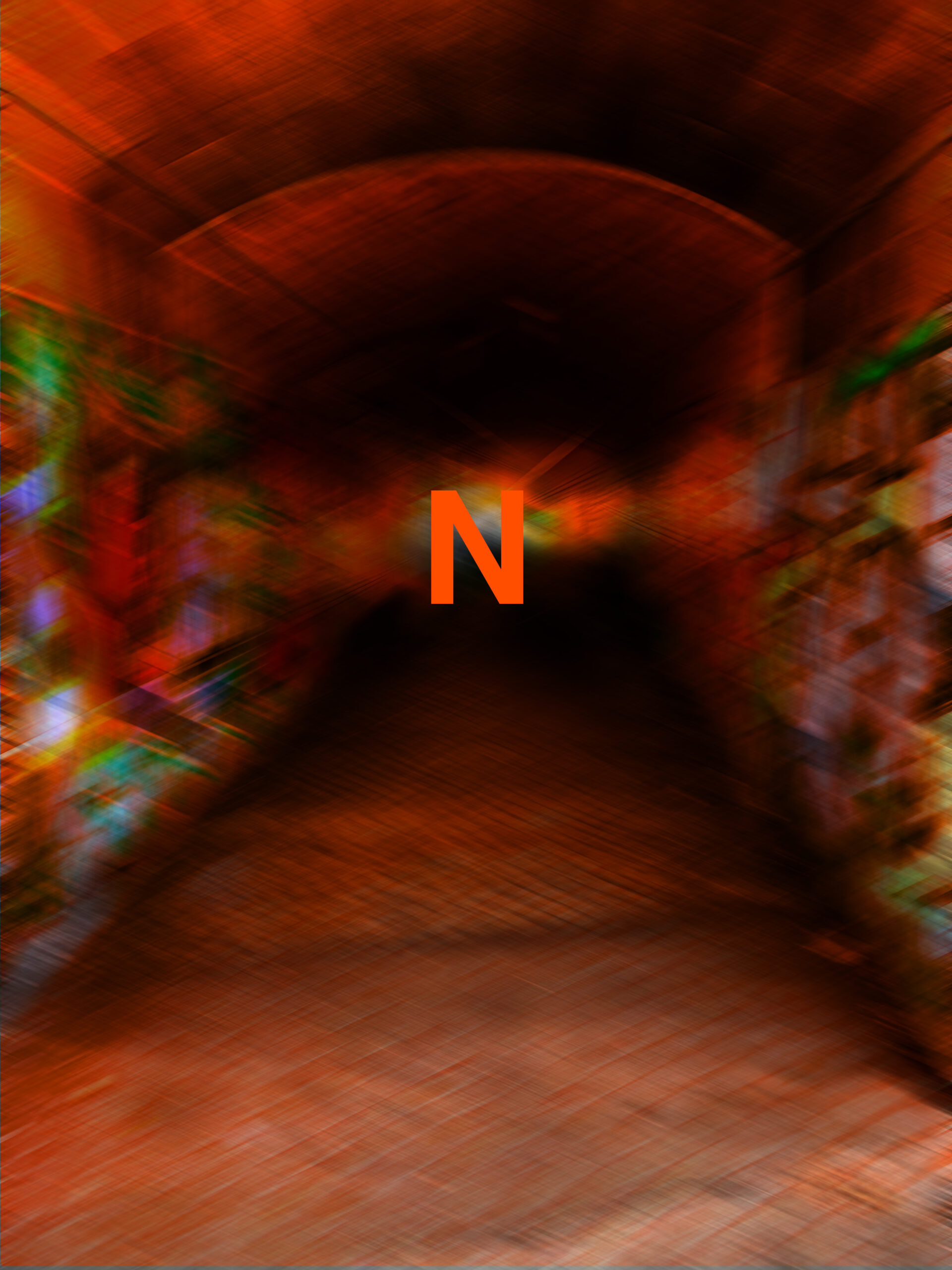
The subject matter of the diaries, experiments, and notes is as follows: Ultimately, these elements are what constitute the creation of art. Similarly, the images created by Alejandro M. Parisi illustrate not only the evolution of the subject matter, but also the progression of the artist’s style. These works not only reflect the artist’s language but also encapsulate the prevailing modes of thought in the present era.
In anticipation of nystada’s forthcoming album here (external link) we present the track “Click’n’Cut.” It is an album that is both intriguing and paradoxical, aligning with the complexities of the contemporary era.


